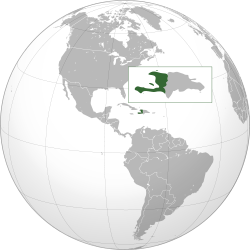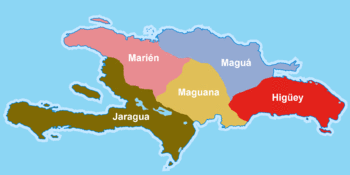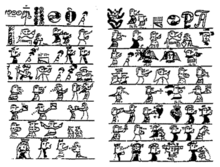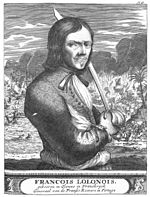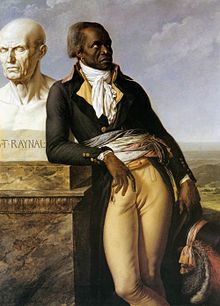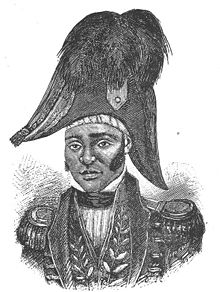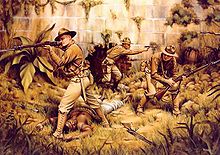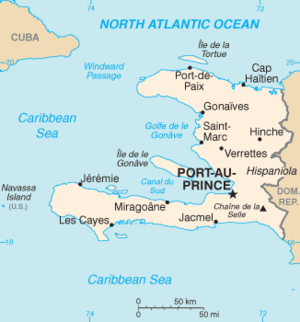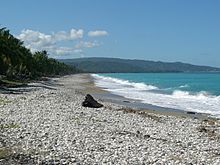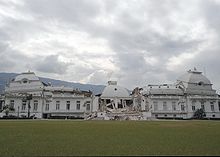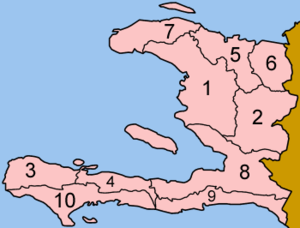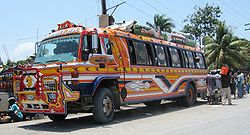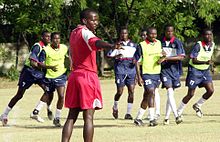
Haiti
About this schools Wikipedia selection
SOS Children have produced a selection of wikipedia articles for schools since 2005. Child sponsorship helps children one by one http://www.sponsor-a-child.org.uk/.
Republic of Haiti
|
||||||
|---|---|---|---|---|---|---|
|
||||||
| Motto: " Liberté, Égalité, Fraternité" (French) Motto on traditional coat of arms:"Freedom, Equality, Brotherhood" "L'union fait la force" (French) "Union makes strength" |
||||||
| Anthem: La Dessalinienne (French) The Dessalines Song |
||||||
|
|
||||||
| Capital and largest city |
Port-au-Prince 18°32′N 72°20′W |
|||||
| Official languages |
|
|||||
| Demonym | Haitian | |||||
| Government | Unitary semi-presidential republic | |||||
| - | President | Michel Martelly | ||||
| - | Prime Minister | Laurent Lamothe | ||||
| Legislature | Parliament | |||||
| - | Upper house | Senate | ||||
| - | Lower house | Chamber of Deputies | ||||
| Formation | ||||||
| - | French colony ( Treaty of Ryswick) |
30 October 1697 | ||||
| - | Independence declared | 1 January 1804 | ||||
| - | Recognized by France | 17 April 1825 | ||||
| Area | ||||||
| - | Total | 27,750 km2 ( 140th) 10,714 sq mi |
||||
| - | Water (%) | 0.7 | ||||
| Population | ||||||
| - | 2011 estimate | 9,719,932 ( 87th) | ||||
| - | Density | 350.27/km2 907.22/sq mi |
||||
| GDP ( PPP) | 2011 estimate | |||||
| - | Total | $12.365 billion | ||||
| - | Per capita | $1,235 | ||||
| GDP (nominal) | 2011 estimate | |||||
| - | Total | $7.388 billion | ||||
| - | Per capita | $738 | ||||
| Gini (2001) | 59.2 high |
|||||
| HDI (2010) | low · 145th |
|||||
| Currency | Gourde ( HTG) |
|||||
| Time zone | EST ( UTC−5) | |||||
| - | Summer ( DST) | ( UTC−4) | ||||
| Drives on the | right | |||||
| Calling code | +509 | |||||
| ISO 3166 code | HT | |||||
| Internet TLD | .ht | |||||
Haiti / ˈ h eɪ t i / (French: Haïti [a.iti]; Haitian Creole Ayiti [ajiti]), officially the Republic of Haiti (République d'Haïti; Repiblik Ayiti), is a Caribbean country. It occupies the western, smaller portion of the island of Hispaniola, in the Greater Antillean archipelago, which it shares with the Dominican Republic. Ayiti (land of high mountains) was the indigenous Taíno or Amerindian name for the island. The country's highest point is Pic la Selle, at 2,680 metres (8,793 ft). The total area of Haiti is 27,750 square kilometres (10,714 sq mi) and its capital is Port-au-Prince. Haitian Creole and French are the official languages.
Haiti's regional, historical, and ethno-linguistic position is unique for several reasons. It was the first independent nation of Latin America and the Caribbean, the first black-led republic in the world, and the second republic in the Americas when it gained independence in 1804 as part of a successful slave revolution lasting nearly a decade. In 2012, Haiti announced its intention to seek associate membership status in the African Union. Haiti is the most populous of the predominantly Francophone independent nations in the Americas. It is one of only two independent nations in the Americas (along with Canada) to designate French as an official language; the other French-speaking areas are all overseas départements, or collectivités, of France.
Haiti is the most populous full member-state of the Caribbean Community (CARICOM). It is the poorest country in the Americas as measured by the Human Development Index. Political violence has occurred regularly throughout its history, leading to government instability. Most recently, in February 2004, a coup d'état originating in the north of the country forced the resignation and exile of President Jean-Bertrand Aristide. A provisional government took control with security provided by the United Nations Stabilization Mission in Haiti (MINUSTAH). Michel Martelly, the current president, was elected in the Haitian general election, 2011.
The island has had a history of destructive earthquakes. A 7.0 magnitude earthquake struck Haiti on 12 January 2010 and devastated Port-au-Prince. The highest reliable death count was estimated at 220,000. Haitian government estimates were higher. The Presidential palace, Parliament and many other important structures were destroyed, along with countless homes and businesses, leaving hundreds of thousands of people homeless. The country has yet to recover from the 2010 earthquake (and subsequent incidents) due to both the severity of the damage Haiti endured in 2010, as well as a government that was ineffective well before the earthquake. United States aid organizations have donated $2 billion. Combined with other international donations, these funds are intended to contribute to the rebuilding of the country.
History
Precolonial and Spanish colonial periods
The island of Hispaniola, of which Haiti occupies the western third, is one of many Caribbean islands inhabited at the time of European arrival by the Taíno Indians, speakers of an Arawakan language. The Taíno name for the entire island was either Ayiti or Kiskeya. In the Taíno societies of the Caribbean Islands, the largest unit of political organization was led by a cacique; the Europeans called these polities caciquedoms or chiefdoms (French caciquat, Spanish cacicazgo). Before the arrival of Christopher Columbus, the island of Hispaniola was divided among five or six long-established caciquedoms.
The caciquedoms were tributary kingdoms, with payment consisting of harvests. Taíno cultural artifacts include cave paintings in several locations in the country, which have become national symbols of Haiti and tourist attractions. Modern-day Léogane, a town in the southwest, is at the site of Xaragua's former capital.
Spanish Hispaniola
Navigator Christopher Columbus landed at Môle Saint-Nicolas on 5 December 1492, and claimed the island for Spain. Nineteen days later, his ship the Santa María ran aground near the present site of Cap-Haïtien. Columbus left 39 men on the island, who founded the settlement of La Navidad. Following the revolts and destruction of La Navidad by the local indigenous people, Columbus moved to the eastern side of the island and established La Isabela. One of the earliest leaders to fight Spanish conquest was the indigenous queen Anacaona, a princess of Xaragua who married Caonabo, the cacique of Maguana. The couple fought Spanish rule but she was captured and executed. Queen Anacaona is revered in Haiti as one of the country's founders.
The island was attractive for its agriculture and gold, and the Spanish mined this valuable resource by the labor of local Amerindians. Some new diseases brought by the Europeans were the chief cause of the dying off of many Taíno people, but ill malnutrition and a drastic drop in the birth rate also contributed. The first recorded smallpox outbreak in the Americas occurred on Hispaniola in 1507. Epidemics of the disease caused high fatalities among the Taíno.
The Spanish passed the Laws of Burgos, 1512–1513, the first codified set of laws in history governing the behaviour of European settlers in America, particularly with regard to native Indians, and one of the earliest examples of international law. The laws forbade the maltreatment of natives, endorsed their conversion to Catholicism, and gave legal framework to encomiendas, where natives were grouped to work in specific plantations or industries. The Spanish crown made efforts to enforce these laws in its colonies, but bureacracy and distance often made it difficult.
With the decline in the Taíno population, the Spanish governors began importing enslaved Africans as laborers. In 1517, Charles V authorized the draft of slaves. The Taíno people became virtually, but not completely extinct on the island of Hispaniola. Some who evaded capture fled to the mountains and established independent settlements. Survivors mixed with escaped African slaves (runaways called maroons) and produced a multiracial generation the Spanish called zambos. They used the term mestizo for those children born to native women and European – usually Spanish – men. The later French settlers called people of mixed African and Amerindian ancestry marabou. The children born of unions between African women and European men were called mulâtres. During the French colonial years, some white fathers sent their mixed-race sons to France to be educated, and passed on social capital in other ways, freeing their slaves mistresses and their children. A class of gens de couleur libre (free people of colour) developed on the island.
As a gateway to the Caribbean, Hispaniola became a haven for pirates. The western part of the island was settled by French buccaneers. Among them was Bertrand d'Ogeron, who succeeded in growing tobacco. His success prompted many of the numerous buccaneers and freebooters to turn into settlers. This population did not submit to Spanish royal authority until the year 1660 and caused a number of conflicts. By 1640, the buccaneers of Tortuga were calling themselves the Brethren of the Coast.
17th-century settlement
Bertrand d'Orgeron attracted many French colonial families from Martinique and Guadeloupe, such as those of Jean Roy, Jean Hebert, and Guillaume Barre. They and others were driven from their lands when more land was needed for the expansion of the sugar plantations, which produced the major commodity crop. From 1670 to 1690, a drop in the tobacco markets significantly reduced the number of settlers on the island.
The first windmill for processing sugar was built in 1685.
Treaty of Ryswick and French colony (1697)
France and Spain settled hostilities on the island by the Treaty of Ryswick of 1697, which divided Hispaniola between them. France received the western third and subsequently named it Saint-Domingue. (The current Santo Domingo is in the Dominican Republic and was part of the eastern Spanish side). Many French colonists soon arrived and established plantations in Saint-Domingue due to high profit potential from agricultural development. They developed large sugar cane plantations, especially, but also devoted land to the cultivation of coffee and indigo. The colonists imported slaves from Africa to work in the labor-intensive cultivation and processing of the commodity crops, and Saint-Domingue became a "slave society," dependent on slavery as the basis of its economy, with the slaveholders comprising the ruling class.
By 1789, approximately 40,000 French colonists lived on the western part of the island. In contrast, by 1763 the French population of Canada, a much larger territory, numbered 65,000. There were ten times the number of imported slaves than there were ethnic French. The largest sugar plantations and concentrations of slaves were in the north of the island, associated with the Plaine-du-Nord.
By about 1790, Saint-Domingue had overshadowed its eastern counterpart in terms of wealth and population. It became the richest French colony in the New World due to the profits from the sugar, coffee and indigo industries, all based on slave labor. The French-enacted Code Noir ("Black Code"), prepared by Jean-Baptiste Colbert and ratified by Louis XIV, had established rules on slave treatment and permissible freedoms. Saint-Domingue has been described as one of the most brutally efficient slave colonies; one-third of newly imported Africans died within a few years. Many slaves died quickly from tropical diseases, smallpox, and typhoid. Some women were suspected of abortions and infanticide to keep children from growing up in slavery.
Under these conditions, French colonists often took sexual advantage of African women. A population of mixed-race people resulted; in some cases, the French fathers provided for their children, especially boys, including sending them to France for education. They also sometimes freed their slave mistresses and the children, and gradually a class of free people of colour ( gens libres de couleur) developed, with certain political rights in the colony. They tended to become artisans, shopkeepers and tradesmen, and more often lived in the towns of the southwest, especially Port-au-Prince, the main city. They also lived in Cap-Français in the north, the major colonial city of the region. Generally growing up Catholic and speaking French, the gens du couleur libre became educated, adopted French styles, and struggled to become independent property owners. They developed as a class apart from the black slaves. Especially in the North, the continuing importation of slaves from Africa meant that they kept more distinctly African cultural traditions.
Revolution (1791)
Inspired by the French Revolution of 1789 and principles of the rights of men, free people of colour and slaves in Saint-Domingue and the French and West Indies pressed for freedom and more civil rights. Most important was the revolution of the slaves in Saint-Domingue, starting in the northern plains in 1791, where Africans greatly outnumbered the whites. They massacred many planters and other whites, and thousands of refugees fled from Saint-Domingue through the next years, settling in United States cities of New York, Philadelphia, Charlestown and New Orleans.
In 1792, the French government sent three commissioners with troops to reestablish control. They began to build an alliance with the free people of colour who wanted more civil rights. In 1793, France and Great Britain went to war, and British troops invaded Saint-Domingue. The execution of Louis XVI heightened tensions in the colony, and refugees continued to leave. That year, 2,000 refugees emigrated to Philadelphia, where they were nearly 5% of the city's population.
To build an alliance with the gens de couleur and slaves, the French commissioners Sonthonax and Polverel abolished slavery in the colony. Six months later, the National Convention, led by Robespierre and the Jacobins, endorsed abolition and extended it to all the French colonies.
Toussaint Louverture, a former slave and leader in the slave revolt — a man who rose in importance as a military commander because of his many skills — achieved peace in 1794 in Saint-Domingue after years of war against both external invaders and internal dissension. Having established a disciplined, flexible army, Louverture drove out not only the Spanish (from Santo Domingo) but also the British invaders who threatened the colony. He restored stability and prosperity by daring measures. These steps included inviting planters to return and insisting freed men work on plantations to renew revenues for the island. He also renewed trading ties with Great Britain and the United States. In the uncertain years of revolution, the United States played both sides, with its traders supplying both the French and the rebels.
Independence and Division (1804)
When the French government changed, new members of the national legislature – lobbied by planters – began to rethink their decisions on colonial slavery. After Toussaint Louverture created a separatist constitution, Napoléon Bonaparte sent an expedition of more than 20,000 men under the command of his brother-in-law, General Charles Leclerc in 1802 to retake the island. Leclerc's mission was to oust Louverture and restore slavery. The French achieved some victories, but within a few months, yellow fever had killed most of the French soldiers. More than 50,000 French troops died in an attempt to retake the colony, including 18 generals. Leclerc invited Toussaint Louverture to a parley, kidnapped him and sent him to France, where he was imprisoned at Fort de Joux. He died there in 1803 of exposure and tuberculosis or malnutrition and pneumonia.
Slaves, along with free gens de couleur and allies continued their fight for independence after the French transported Louverture to France. The native leader Jean-Jacques Dessalines – long an ally and general of Toussaint Louverture, brilliant strategist and soldier – defeated French troops led by Donatien-Marie-Joseph de Vimeur, vicomte de Rochambeau, at the Battle of Vertières. In late 1803, France withdrew its remaining 7,000 troops from the island and Napoleon gave up his idea of re-establishing a North American empire. With the war going badly, he sold Louisiana to the United States.
At the end of the double battle for emancipation and independence, former slaves proclaimed the independence of Saint-Domingue on 1 January 1804, declaring the new nation be named "Ayiti", both a Native American and African term, meaning "home or mother of the earth" in the Taíno-Arawak Native American language and "sacred earth or homeland" in the Fon African language, to honour one of the indigenous Taíno names for the island.
Haiti is the only contemporary nation born of a slave revolt. Historians have estimated the slave rebellion resulted in the deaths of 100,000 blacks and 24,000 of the 40,000 white colonists, as well as many free people of colour. The United States President Thomas Jefferson continued an arms and goods embargo against the new country. Due to the pressure of southern Congressmen, who feared their slaves being encouraged by the revolt, the United States refused to recognize Haiti's new government until 1867. Americans feared potential slave rebellions incited by free blacks and, after 1810, reduced the number of manumissions in the South, which had increased markedly in the first two decades following its own Revolution.
In February 2010, the eight-page document containing the official Declaration of Independence, which was believed to have been destroyed or thrown out, was found by a Canadian graduate student from Duke University in Britain's National Archives. Coming as it did soon after the 2010 devastating earthquake, many see the discovery as providential.
The revolution in Saint-Domingue unleashed a massive multiracial exodus: French Créole colonists fled with those slaves they still held, as did numerous free people of colour, some of whom were also slaveholders and transported slaves with them. In 1809, nearly 10,000 refugees from Saint-Domingue arrived through Cuba, where they had first fled, to settle en masse in New Orleans. They doubled that city's population and helped preserve its French language and culture for several generations. In addition, the newly arrived slaves added to the city's African and multiracial culture.
Dessalines was proclaimed "Emperor for Life" by his troops. He exiled or killed the remaining whites and ruled as a despot. In the continuing competition for power, he was assassinated on 17 October 1806. The country was then divided between a kingdom in the north directed by Henri I; and a republic in the south directed by Alexandre Pétion, an homme de couleur. Henri I is best known for constructing the Citadelle Laferrière, the largest fortress in the Western Hemisphere, to defend the island against the French. Despite opposition from the mulatto populace, Henri Christophe successfully united Northern Haiti for a period of time under a semi-feudal corvée system, establishing a rigid education and economic code aimed at sustainable improvement for all Haitians.
In 1815, Simón Bolívar, the South American political leader who was instrumental in Latin America's struggle for independence from Spain, received military and financial assistance from Haiti. Bolívar had fled to Haiti after an attempt had been made on his life in Jamaica, where he had unsuccessfully sought support for his efforts. In 1817, on condition that Bolívar free any enslaved people he encountered in his fight for South American independence, Haitian president Pétion provided Bolívar with soldiers, weapons and financial assistance, which were critical in enabling him to liberate the Viceroyalty of New Granada (now Colombia, Ecuador, Panama and Venezuela).
Reunification
Beginning in 1821, President Jean Pierre Boyer, also an homme de couleur and successor to Pétion, managed to reunify the two parts of St. Domingue and extend control over the western part of the island. In addition, after Santo Domingo declared its independence from Spain, Boyer sent forces in to take control. Boyer then ruled the entire island. According to Encyclopædia Britannica, "During his presidency, Boyer tried to halt the downward trend of the economy—which had begun with the successful revolt of black slaves against their French masters in the 1790s—by passing the Code Rural. Its provisions sought to tie the peasant labourers to plantation land by denying them the right to leave the land, enter the towns, or start farms or shops of their own and by creating a rural constabulary to enforce the code."
During Boyer's administration, his government negotiated with Loring D. Dewey, an agent of the American Colonization Society (ACS), to encourage free blacks from the United States to emigrate to Haiti. They hoped to gain people with skills to contribute to the independent nation. In the early 19th century, the ACS – an uneasy blend of abolitionists and slaveholders – proposed resettlement of American free blacks to other countries, primarily to a colony in Liberia, as a solution to problems of racism in the US. Starting in September 1824, more than 6,000 American free blacks migrated to Haiti, with transportation paid by the ACS. Due to the poverty and other difficult conditions there, many returned to the US within a short time.
In July 1825, King Charles X of France sent a fleet of 14 vessels and thousands of troops to reconquer the island. Under pressure, President Boyer agreed to a treaty by which France formally recognized the independence of the nation in exchange for a payment of 150 million francs (reduced to 90 million in 1838) – an indemnity for profits lost from the slave trade. French abolitionist Victor Schoelcher wrote, "Imposing an indemnity on the victorious slaves was equivalent to making them pay with money that which they had already paid with their blood."
After losing the support of Haiti's elite, Boyer was ousted in 1843. A long succession of coups followed his departure to exile. National authority was disputed by factions of the army, the elite class, and the growing commercial class, increasingly made up of numerous immigrant businessmen: Germans, Americans, French and English.
In 1912, Syrians residing in Haiti participated in a plot in which the Presidential Palace was destroyed. On more than one occasion, French, US, German and British forces allegedly claimed large sums of money from the vaults of the National Bank of Haiti. Expatriates bankrolled and armed opposing groups.
In addition, national governments intervened in Haitian affairs. In 1892, the German government supported suppression of the reform movement of Anténor Firmin. In January 1914, British, German and US forces entered Haiti, ostensibly to protect their citizens from civil unrest.
United States occupation of Haiti (1915–1934)
In an expression of the Roosevelt Corollary to the Monroe Doctrine, the United States occupied the island in 1915 and US Marines were stationed in the country until 1934. According to Monroe, treaties in 1915 and 1917 gave the U.S. State and Navy departments (and the Navy's Marine Corps) effective control over key government roles; the U.S. assumed responsibility for maintaining domestic peace and put down several small rebellions such as the "Cacos" uprising. Haiti had huge debts, which were refinanced by new loans from the National City Bank of New York, and paid off by American government officials who took control of customs and the national budget. The U.S. transformed the Garde into a modern police force and built up advanced public health, education, ports and roads.
According to Paul Farmer, the US administration dismantled the constitutional system, reinstituted virtual slavery for building roads, and established the National Guards that ran the country by violence and terror after the Marines left. It also made massive improvements to infrastructure: 1,700 kilometres (1,100 mi) of roads were made usable; 189 bridges were built; many irrigation canals were rehabilitated; hospitals, schools, and public buildings were constructed, and drinking water was brought to the main cities. Sisal was introduced to Haiti, and sugar and cotton became significant exports. The U.S. Marines supervised the operations of a client Haitian government, and emphasized American-style modernization of the infrastructure and universal education. Haitian traditionalists were highly resistant to these changes while the urban elites wanted more control. Together they helped force an end to the occupation in 1934. President Herbert Hoover sent a commission that set up a plan of withdrawal that was achieved under President Franklin D. Roosevelt. The first step was a gradual, systematic turnover of government functions to the Haitian government; in 1934 it took control of the Garde and the Marines departed. The debts were still outstanding and the American financial advisor-general receiver handled the budget until 1941.
In 1915, Philippe Sudré Dartiguenave was elected president. He was succeeded by Louis Borno in the 1922 elections. Borno worked closely with the Americans. Aware that many Haitians did not speak French, he was the first president to authorize the use of Creole in the education system. Recognition of the distinctive traditionalism of the Haitian people had a sharp impact on black writers in the U.S. (as well as white writers exploring black themes), including Eugene O'Neill, James Weldon Johnson, Langston Hughes, Zora Neale Hurston and Orson Welles.
End of US occupation until election of Duvalier (1934–1956)
The US occupation forces established a boundary between Haiti and the Dominican Republic by taking disputed land from the latter. After the US left in 1934, Dominican dictator Rafael Trujillo – in an event known as the Parsley Massacre – ordered his Army to kill Haitians living on the Dominican side of the border. In a "three-day genocidal spree", he murdered between 10,000 and 20,000 Haitians. He then developed a uniquely Dominican policy of racial discrimination, Antihaitianismo ("anti-Haitianism"), targeting the mostly black inhabitants of his neighboring country.
Sténio Vincent was succeeded as President in 1941 by Élie Lescot. In 1949, Lescot tried to change the constitution to allow for his own reelection, but in 1950 this triggered another coup. General Paul Magloire led the country until December 1956, when he was forced to resign by a general strike. After a period of disorder, an election held in September 1957 saw Dr. François Duvalier elected President.
Duvalier family dictatorship (1957–1986)
From 1957 to 1986 Haiti was governed by the hereditary dictatorship of the Duvalier family.
Former minister of health and labor François Duvalier, known as "Papa Doc" and initially popular among the black population of the nation, was the President of Haiti from 1957 until his death in 1971. A strong believer in the rights of the Haitian black majority, he advanced black interests in the public sector. He stayed in power by enlisting an organization known as Tontons Macoutes ("Bogeymen"), which maintained order by terrorizing the populace.
In the 1960s and 1970s, Haiti's diaspora made vital contributions to the establishment of francophone Africa's newly independent countries as Haiti's university professors, medical doctors, administrators and development specialists emigrated to these countries.
"Papa Doc" was succeeded by his son (born 3 July 1951) Jean-Claude Duvalier – known also as "Bébé Doc" – who led the country from 1971 until his ouster in 1986. In 1986, protests against "Baby Doc" led him to seek exile in France. Army leader General Henri Namphy headed a new National Governing Council.
In March 1987, a new constitution was overwhelmingly approved by Haiti's population. General elections in November were aborted after dozens of inhabitants were shot in the capital by soldiers and Tontons Macoutes, and scores more were massacred around the country. Fraudulent military-controlled elections followed, boycotted by opposition candidates, and the elected President, Leslie Manigat, was overthrown some months later in the June 1988 Haitian coup d'état when he sought to assert his constitutional control over the military. The September 1988 Haitian coup d'état followed after the St Jean Bosco massacre brought to the fore the increasing prominence of former Tontons Macoutes, and General Prosper Avril led a military regime until March 1990. Throughout the late 1980s and into the 1990s, leading members of the military, intelligence and police were involved in the illegal drug trade in Haiti, assisting Colombian drug traffickers smuggling drugs into the United States.
Aristide's presidency (1990s)
In December 1990, the former priest Jean-Bertrand Aristide was elected President in the Haitian general election, winning more than two thirds of the vote. His 5-year mandate began on 7 February 1991, having survived a coup attempt even before his inauguration, when former Tonton Macoute leader Roger Lafontant seized the provisional President Ertha Pascal-Trouillot and declared himself President. After large numbers of Aristide supporters filled the streets in protest and Lafontant attempted to declare martial law, the Army crushed the incipient coup.
During Aristide's short-lived first period in office, he attempted to carry out substantial reforms, which brought passionate opposition from Haiti's business and military elite. His relationship with the National Assembly soon deteriorated, partly over his selection of his friend René Préval as Prime Minister. In September, Aristide was overthrown in the 1991 Haitian coup d'état, led by Army General Raoul Cédras, and flown into exile. Elections were scheduled, but then cancelled. The Organization of American States condemned the coup, and the United Nations set up a trade embargo. A campaign of terror against Aristide supporters was started by Emmanuel Constant. In 1993, Constant, who had been on the U.S. Central Intelligence Agency's payroll as an informant since 1992, organized the Front for the Advancement and Progress of Haïti (FRAPH), which targeted and killed an estimated 5000 Aristide supporters.
In 1994, an American team, under the direction of the Clinton Administration, successfully negotiated the departure of Haiti's military leaders and the peaceful entry of US forces under Operation Uphold Democracy, thereby paving the way for the restoration of Jean-Bertrand Aristide as president. In October 1994, Aristide returned to Haiti to complete his term in office. Aristide disbanded the Haitian army, and established a civilian police force.
Aristide vacated the presidency in February 1996, the scheduled end of his 5-year term based on the date of his inauguration. In the 1995 election, René Préval was elected as president for a five-year term, winning 88% of the popular vote. Préval had previously served as Aristide's Prime Minister from February to October 1991.
21st century
The November 2000 election gave the presidency back to Aristide with an overwhelming 92% of the vote. The election had been boycotted by the opposition, now organized into the Convergence Démocratique, over a dispute in the May legislative elections. In subsequent years, there was increasing violence and human rights abuses. Aristide supporters attacked the opposition. Aristide spent years negotiating with the Convergence Démocratique on new elections, but the Convergence's inability to develop a sufficient electoral base made elections unattractive.
In 2004, a revolt began in northern Haiti. The rebellion eventually reached the capital; and Aristide was forced into exile, whereupon the United Nations stationed peacekeepers in Haiti. Much evidence points to a key U.S. role in Aristide's ouster, with Aristide and his bodyguard, Franz Gabriel, claiming that he was the victim of a "new coup d'état or modern kidnapping" by U.S. forces. Mrs. Aristide stated that the kidnappers wore US Special Forces uniforms, but changed into civilian clothes upon boarding the aircraft that was used to remove Aristide from Haiti. Boniface Alexandre assumed interim authority. René Préval was elected President in February 2006, following elections marked by uncertainties and popular demonstrations. The United Nations Stabilization Mission in Haiti (also known as MINUSTAH) remains in the country, having been there since the 2004 coup d'etat. The United States led a vast international campaign to prevent Aristide from returning to his country while he was exiled in South Africa. Released Wikileaks cables show that high-level U.S. and U.N. officials coordinated a politically motivated prosecution of Aristide to prevent him from "gaining more traction with the Haitian population and returning to Haiti." The United States and its allies allegedly poured tens of millions of dollars into unsuccessful efforts to slander Aristide as a drug trafficker, human rights violator, and heretical practitioner of voodoo.
Michèle Pierre-Louis was the second female Prime Minister of Haiti (September 2008-Nov. 2009). Claudette Werleigh (1995–1996) was the first.
2010–2011: Earthquake, cholera, and flooding
The 2010 Haiti earthquake left up to 316,000 people dead and 1.6 million homeless. Massive homelessness and displacement continues and does not appear to have significantly abated. Government agencies were also hard hit. Two days afterwards thousands of U.S. troops arrived to aid in the earthquake relief effort and relief agencies are playing a large role in rebuilding Haiti's infrastructure, while taking care of the short-term emergency needs of the many injured and displaced Haitians.
In October 2010 a cholera epidemic was identified. On 14 October, the first cases of diarrhea, acute fever, vomiting, and severe dehydration were observed in Haiti, northwest of Port-au-Prince, near the banks of Meye river, next to Mirebalais, Three weeks later, Hurricane Tomas worsened the situation by mixing polluted bodies of water. On 22 October, the Pan American Health Organization recorded 183 deaths. These increased after the hurricane. The World Health Organization reported 1,415 deaths on 20 November. The Haitian Ministry of Health reported 3,333 deaths and 148,787 infected persons on 26 December. Cholera had never been observed in Haiti., "The U.S. Centers for Disease Control and Prevention found that the cholera strain ravaging the country matched a strain specific to South Asia, but said they had not pinpointed its origin or how it arrived in Haiti." The expert panel appointed by the UN concluded that the cholera epidemic in Haiti was due to contamination of the Meye River, a tributary of the Artibonite River, with a pathogenic strain of Vibrio cholerae of South Asian origin resulting from human activities.
General elections had been planned for January 2010, but were postponed due to the earthquake. The elections were held on 28 November 2010 for senate, parliament and the first round of the presidential elections. The run-off between Michel Martelly and Mirlande Manigat took place on 20 March 2011, and preliminary results, released on 4 April, named Michel Martelly the winner.
Geography
Haiti is on the western part of Hispaniola, the second largest island in the Greater Antilles. Haiti is the third largest country in the Caribbean behind Cuba and the Dominican Republic (the latter shares a 360-kilometre (224 mi) border with Haiti). Haiti at its closest point is only about 45 nautical miles (83 km; 52 mi) away from Cuba and has the second longest coastline (1,771 km/1,100 mi) in the Greater Antilles, Cuba having the longest. The country lies mostly between latitudes 18° and 20°N ( Tortuga island lies just north of 20°), and longitudes 71° and 75°W. Haiti's terrain consists mainly of rugged mountains interspersed with small coastal plains and river valleys.
The northern region consists of the Massif du Nord (Northern Massif) and the Plaine du Nord (Northern Plain). The Massif du Nord is an extension of the Cordillera Central in the Dominican Republic. It begins at Haiti's eastern border, north of the Guayamouc River, and extends to the northwest through the northern peninsula. The lowlands of the Plaine du Nord lie along the northern border with the Dominican Republic, between the Massif du Nord and the North Atlantic Ocean. The central region consists of two plains and two sets of mountain ranges. The Plateau Central (Central Plateau) extends along both sides of the Guayamouc River, south of the Massif du Nord. It runs from the southeast to the northwest. To the southwest of the Plateau Central are the Montagnes Noires, whose most northwestern part merges with the Massif du Nord. Its westernmost point is known as Cap Carcasse.
The southern region consists of the Plaine du Cul-de-Sac (the southeast) and the mountainous southern peninsula (also known as the Tiburon Peninsula). The Plaine du Cul-de-Sac is a natural depression that harbors the country's saline lakes, such as Trou Caïman and Haiti's largest lake, Lac Azuéi. The Chaîne de la Selle mountain range – an extension of the southern mountain chain of the Dominican Republic (the Sierra de Baoruco) – extends from the Massif de la Selle in the east to the Massif de la Hotte in the west. This mountain range harbors Pic la Selle, the highest point in Haiti at 2,680 metres (8,793 ft).
The country's most important valley in terms of crops is the Plaine de l'Artibonite, which is oriented south of the Montagnes Noires. This region supports the country's (also Hispaniola's) longest river, the Riviere l'Artibonite, which begins in the western region of the Dominican Republic and continues most of its length through central Haiti and onward where it empties into the Golfe de la Gonâve. The eastern and central region of the island is a large elevated plateau. Haiti also includes various offshore islands. The historically famous island of Tortuga (Île de la Tortue) is located off the coast of northern Haiti. The arrondissement of La Gonâve is located on the island of the same name, in the Golfe de la Gonâve. Gonâve Island is moderately populated by rural villagers. Île à Vache (Cow Island), a lush island with many beautiful sights, is located off the tip of southwestern Haiti. Also part of Haiti are the Cayemites and Île d' Anacaona. La Navasse located 40 nautical miles (46 mi; 74 km) west of Jérémie on the south west peninsula of Haiti, is subject to an on-going territorial dispute with the United States.
Geology
Faults
There are blind thrust faults associated with the Enriquillo-Plantain Garden fault system over which Haiti lies. After the Earthquake of 2010, there was no evidence of surface rupture and based on seismological, geological and ground deformation data.
The northern boundary of the fault is where the Caribbean tectonic plate shifts eastwards by about 20 mm (0.79 inches) per year in relation to the North American plate. The strike-slip fault system in the region has two branches in Haiti, the Septentrional-Oriente fault in the north and the Enriquillo-Plantain Garden fault in the south.
A 2007 earthquake hazard study by C. DeMets and M. Wiggins-Grandison noted that the Enriquillo-Plantain Garden fault zone could be at the end of its seismic cycle and concluded that a worst-case forecast would involve a 7.2 Mw earthquake, similar in size to the 1692 Jamaica earthquake. Paul Mann and a group including the 2006 study team presented a hazard assessment of the Enriquillo-Plantain Garden fault system to the 18th Caribbean Geologic Conference in March 2008, noting the large strain; the team recommended "high priority" historical geologic rupture studies, as the fault was fully locked and had recorded few earthquakes in the preceding 40 years. An article published in Haiti's Le Matin newspaper in September 2008 cited comments by geologist Patrick Charles to the effect that there was a high risk of major seismic activity in Port-au-Prince.
Flora
In 1925, Haiti was lush, with 60% of its original forest covering the lands and mountainous regions. Since then, Haiti's residents have cut down an estimated 98% of its original forest cover for use as fuel for cookstoves, and in the process have destroyed fertile farmland soils, contributing to desertification.
Environment
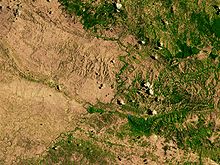
In addition to soil erosion, deforestation has caused periodic flooding, as seen on 17 September 2004. Earlier that year in May, floods had killed over 3,000 people on Haiti's southern border with the Dominican Republic.
There has been little marine, coastal, and river basin management. Forest cover in the steep hills surrounding Haiti's river basin retains soil, which in turn retains water from rainfall, reducing river flood peaks and conserving flows in the dry season. But deforestation has resulted in much of the soil being released from the upper catchments. Many of Haiti's rivers are now highly unstable, changing rapidly from destructive flooding to inadequate flows. Scientists at the Columbia University's Centre for International Earth Science Information Network (CIESIN) and the United Nations Environment Programme are working on the Haiti Regenerative Initiative an initiative aiming to reduce poverty and natural disaster vulnerability in Haiti through ecosystem restoration and sustainable resource management.
Natural disasters
Hurricanes and tropical storms
In 2004, Tropical Storm Jeanne skimmed the north coast of Haiti, leaving 3,006 people dead in flooding and mudslides, mostly in the city of Gonaïves.
Haiti was again pummeled by tropical storms in late August and early September 2008. The storms – Tropical Storm Fay, Hurricane Gustav, Hurricane Hanna and Hurricane Ike – all produced heavy winds and rain in Haiti. Due to weak soil conditions throughout Haiti, the country's mountainous terrain, and the devastating coincidence of four storms within less than four weeks, valley and lowland areas throughout the country experienced massive flooding. Casualties proved difficult to count because the storm diminished human capacity and physical resources for such record keeping. Bodies continued to surface as the flood waters receded. A 10 September 2008 source listed 331 dead and 800,000 in need of humanitarian aid. The grim state of affairs produced by these storms was all the more life threatening due to already high food and fuel prices that had caused a food crisis and political unrest in April 2008.
2010 earthquake
On 12 January 2010, at 21:53 UTC, (4:53 pm local time) Haiti was struck by a magnitude-7.0 earthquake, the country's most severe earthquake in over 200 years. The epicenter of the quake was just outside the Haitian capital Port-au-Prince. On 10 February the Haitian government gave a death toll of 230,000. Widespread damage resulted from the quake, and the capital city was devastated.
The Presidential Palace was badly damaged, the second floor collapsing onto the first floor; the Haitian Parliament building, UN mission headquarters and the National Cathedral were also destroyed. International aid flowed in but was hampered by damaged infrastructure: the main port was damaged beyond immediate use, the one local airport was of limited capacity, and border crossings with the Dominican Republic were distant and crowded.
As many as one million Haitians were left homeless. Over a million Haitians moved into tent camps plagued with problems including violence, rape, and insufficient food, work, and security.
Haiti must be completely rebuilt from the ground up, according to a journalist, as, "[e]ven in good times, Haiti is an economic wreck, balancing precariously on the razor's edge of calamity." Several international appeals were launched within days of the earthquake, including the Disasters Emergency Committee in the United Kingdom, Young Artists for Haiti (Canada) and Hope for Haiti Now: A Global Benefit for Earthquake Relief based in the USA, which was a global effort to raise relief funds by way of a charity telethon held on 22 January 2010. International officials are looking at the short and long term priorities while continuing the daily task of managing the emergency situation. As of September 2010, there were over one million refugees living in tents and the humanitarian situation was characterized as still being in the emergency phase.
On 31 May 2011, BBC News reported that a new report challenges Haiti's official earthquake death toll. "Significantly fewer people died or were left homeless by last year's earthquake in Haiti than claimed by the country's leaders, a draft report commissioned by the US government has said. The unpublished report puts the death toll between 46,000 and 85,000. (Haiti's government says about 316,000 died.) It also suggests many of those still living in tent cities did not lose their homes in the disaster. The draft report, which has yet to be released publicly, is based on a survey commissioned by the US Agency for International Development (USAID) and draws its numbers from door-to-door surveys carried out over 29 days in January 2011."
Demographics
Although Haiti averages approximately 250 people per square kilometer (650 per sq mi.), its population is concentrated most heavily in urban areas, coastal plains, and valleys. Haiti's population was about 9.8 million according to UN 2008 estimates, with half of the population being under 20 years. The first formal census, taken in 1950, showed that the population was 3.1 million.
85% of Haitians (depending on the source because the Haitian government does not conduct a census) are primarily of African descent; the remaining 15–20% of the population are mostly of mixed-race background. Smaller minority groups include people of Western European (French, German, Polish, Portuguese and Spanish), Arab, Armenian, or Jewish origin. Haitians of East Asian descent or East Indian origin number approximately 400.
Largest cities
| Largest cities or towns of Haiti http://www.geonames.org/HT/largest-cities-in-haiti.html |
|||||||||
|---|---|---|---|---|---|---|---|---|---|
| Rank | City name | Department | Pop.
|
||||||
 Port au Prince |
1 | Port au Prince | Ouest | 1,234,800 | |||||
| 2 | Carrefour | Ouest | 442,156 | ||||||
| 3 | Delmas | Ouest | 382,920 | ||||||
| 4 | Pétionville | Ouest | 283,052 | ||||||
| 5 | Croix des Bouquets | Ouest | 229,127 | ||||||
| 6 | Jacmel | Sud-Est | 137,966 | ||||||
| 7 | Cap-Haïtien | Nord | 134,815 | ||||||
| 8 | Léogâne | Ouest | 134,190 | ||||||
| 9 | Les Cayes | Sud | 125,799 | ||||||
| 10 | Petit Goâve | Ouest | 117,504 | ||||||
Haitian diaspora
Millions of Haitians live abroad in the Dominican Republic, United States, Cuba, Canada (primarily Montreal), Bahamas, France, French Antilles, the Turks and Caicos, Jamaica, Puerto Rico, Venezuela and French Guiana. There are an estimated 800,000 Haitians in the Dominican Republic, 600,000 in the United States, 100,000 in Canada, 80,000 in France, and up to 80,000 in the Bahamas. But there are also smaller Haitian communities in many other countries, including Chile, Switzerland, Brazil, Japan and China.
Religion
Around 80% of Haitians profess to be Catholics. Protestants make up about 16% of the population. Some Haitians combine their Catholicism with elements of Voodoo.
Languages
One of Haiti's two official languages is French, which is the principal written and administratively authorized language. It is spoken by all educated Haitians, is spoken in schools, and is used in the business sector. It is also used in ceremonial events such as weddings, graduations and church masses. The second is the recently standardized Haitian Creole, which is spoken by virtually the entire population of Haiti. Haitian Creole is one of the French-based creole languages. It is closely related to French, but is also influenced by African languages, as well as Taino, Spanish, English, Portuguese and Arabic. Haitian Creole is related to the other French creoles, but most closely to Mauritian creole and Louisiana Creole.
Government
The government of Haiti is a semi-presidential republic, a multiparty system wherein the President of Haiti is head of state elected directly by popular elections. The Prime Minister acts as head of government and is appointed by the President, chosen from the majority party in the National Assembly. Executive power is exercised by the President and Prime Minister who together constitute the government.
Legislative power is vested in both the government and the two chambers of the National Assembly of Haiti. The government is organized unitarily, thus the central government delegates powers to the departments without a constitutional need for consent. The current structure of Haiti's political system was set forth in the Constitution of Haiti on 29 March 1987. The current president is Michel Martelly.
In 2010, there were 7,000 people in the Haitian National Police.
The Institute for the Protection of National Heritage has preserved 33 historical monuments and the historic centre of Cap-Haïtien.
The legal system for torts is based on a version of the Napoleonic Code.
Departments, arrondissements, and communes
For reasons of administration, Haiti has been divided into ten departments. The departments are listed below, with the departmental capital cities in parentheses.
- Artibonite ( Gonaïves)
- Centre ( Hinche)
- Grand'Anse ( Jérémie)
- Nippes ( Miragoâne)
- Nord ( Cap-Haïtien)
- Nord-Est ( Fort-Liberté)
- Nord-Ouest ( Port-de-Paix)
- Ouest (Port-au-Prince)
- Sud-Est ( Jacmel)
- Sud ( Les Cayes)
The departments are further divided into 41 arrondissements, and 133 communes, which serve as second- and third-level administrative divisions.
Politics
General
Haitian politics have been contentious: in its 200-year history, Haiti has suffered 32 coups. Haiti is the only country in the Western Hemisphere to undergo a successful slave revolution, but a long history of oppression by dictators – including François Duvalier and his son Jean-Claude Duvalier – has markedly affected the nation. France and the United States have repeatedly intervened in Haitian politics since the country's founding, sometimes at the request of one party or another.
According to a Corruption Perceptions Index report in 2006, there is a strong correlation between corruption and poverty and Haiti ranked first of all countries surveyed for of levels of perceived domestic corruption. The International Red Cross reports that seven out of ten Haitians live on less than US$2 a day.
Cité Soleil, Haiti's largest slum in the capital of Port-au-Prince, has been called "the most dangerous place on Earth" by the United Nations. The slum is a stronghold of supporters of former Haitian President Jean-Bertrand Aristide, who, according to the BBC, "accused the US of forcing him out – an accusation the US rejected as 'absurd'".
Jean-Claude Duvalier suddenly returned to Haiti in late January 2011, claiming his doing so was out of concern for the present situation in Haiti. On the other hand, Jean-Bertrand Aristide was initially denied access to Haiti by Haitian immigration authorities, despite issuing appeals to his supporters, and to international observers, to be able to enter. The world's most prominent governments did not overtly oppose such appeals, nor did they support them; an unnamed analyst 'close to the Haitian government' who was repeatedly quoted in several media sources including the New York Times, is reported to have commented, "Aristide could have 15 passports and he's still not going to come back to Haiti. ...France and the United States are standing in the way." However, Aristide finally returned to Haiti just days before the 2011 Presidential election, on 18 March 2011.
In February 2012, Haiti signaled it would seek to upgrade its observer status to full associate member status of the African Union (AU). The AU plans at its next summit in June 2013 to upgrade Haiti's status from observer to associate.
Elections
The first round of the 2010 Haiti Elections, was held in December and qualified Mirlande Manigat and Jude Celestin for the second round, but the results of the election were contested. Some people said that the first round was a fraud, and that Michel Martelly should be in the place of Jude Celestin, René Préval's chosen successor. There was some violence between the contending parties.
On 4 April 2011 the Provisional Electoral Council announced preliminary results that Martelly had won the presidential election.
Economy
Haiti's economy is still recovering from the massive earthquake in January 2010. Its purchasing power parity GDP fell 8% in 2010 (from $12.15 billion to $11.18 billion) and the GDP per capita remained unchanged at (PPP US$) 1,200. Comparative social and economic indicators show Haiti falling behind other low-income developing countries (particularly in the hemisphere) since the 1980s. Haiti ranked 145 of 182 countries in the 2010 United Nations Human Development Index, with 57.3% of the population being deprived in at least three of the HDI's poverty measures.
The World Factbook reports a shortage of skilled labor, widespread unemployment and underemployment, saying "more than two-thirds of the labor force do not have formal jobs", and describes pre-earthquake Haiti as "already the poorest country in the Western Hemisphere with 80% of the population living under the poverty line and 54% in abject poverty." Most Haitians live on $2 or less per day.
Adult literacy is variously reported as 52.9% [World Factbook] and 65.3% [United Nations], and the World Bank estimates that in 2004 over 80% of college graduates from Haiti were living abroad, with their remittances home representing 52.7% of Haiti's GDP. Cité Soleil is considered one of the worst slums in the Americas; most of its 500,000 residents live in extreme poverty. Poverty has forced at least 225,000 Haitian children to work as restavecs (unpaid household servants). The United Nations considers this a modern-day form of slavery.
About 66% of all Haitians work in the agricultural sector, which consists mainly of small-scale subsistence farming, but this activity makes up only 30% of the GDP. The country has experienced little formal job-creation over the past decade, although the informal economy is growing. Mangoes and coffee are two of Haiti's most important exports.
Natural resources of Haiti include bauxite, copper, calcium carbonate, gold, marble and hydropower. Haiti contains relatively small amounts of gold, silver, antimony, tin, lignite, sulphur, coal, nickel, gypsum, limestone, manganese, marble, iron, tungsten, salt, clay, and various building stones. Gold and copper are found in small quantities in the north of the country. The government announced the discovery of new gold deposits in the northern peninsula in 1985, but long-standing plans for gold production proceeded slowly. Copper also was mined, beginning in the 1960s, but production of the ore was sporadic. There are bauxite (aluminium ore) deposits on the southern peninsula, but large scale mining there was discontinued in 1983. The country's only bauxite mine, the Miragoâne mine in the southern peninsula, produced an average of 500,000 tons of bauxite a year in the early 1980s; however, in 1982 the declining metal content of the ore, high production costs, and the oversupplied international bauxite market forced the mine to close. Bauxite had at one time been the country's second leading export. Haiti apparently has no hydrocarbon resources on land or in the Gulf of Gonâve and is therefore heavily dependent on energy imports (petroleum and petroleum products).
Haiti's richest 1% own nearly half the country's wealth.
Haiti has consistently ranked among the most corrupt countries in the world on the Corruption Perceptions Index. Since the day of "Papa Doc" Duvalier, Haiti's government has been notorious for its corruption. It is estimated that President "Baby Doc" Duvalier, his wife Michelle, and three other people took $504 million from the Haitian public treasury between 1971 and 1986.
Similarly, some media outlets alleged that millions were stolen by former president Jean-Bertrand Aristide. However the accuracy of the information is questionable and may have been concocted to discredit Aristide. In March 2004, at the time of Aristide's being kidnapped, a BBC article wrote that the Bush administration State department claimed that Aristide had been involved in drug trafficking. The BBC also described pyramid schemes, in which Haitians lost hundreds of millions in 2002, as the "only real economic initiative" of the Aristide years. However this cannot necessarily be entirely blamed on Aristide since one of his conditions upon being returned to Haiti by the Clinton administration during the 90s was that he not stir the pot away from US Free Market Trade Policies. Clinton recently expressed regret and apologized for the US's trade policies with Haiti Aristide however decided against being further tied to the free market policies that he was restricted to, and he attempted to raise the country's minimum wage.
Foreign aid makes up approximately 30–40% of the national government's budget. The largest donor is the US, followed by Canada and the European Union. From 1990 to 2003, Haiti received more than $4 billion in aid. The United States alone had provided Haiti with 1.5 billion in aid. Venezuela and Cuba also make various contributions to Haiti's economy, especially after alliances were renewed in 2006 and 2007. In January 2010, China promised $4.2 million for the quake-hit island. US President Barack Obama pledged $1.15 billion in assistance. European Union nations promised more than 400 million euros ($616 million) in emergency aid and reconstruction funds.
US aid to the Haitian government was completely cut off from 2001 to 2004, after the 2000 election was disputed and President Aristide was accused of various misdeeds. After Aristide's departure in 2004, aid was restored, and the Brazilian army led the United Nations Stabilization Mission in Haiti peacekeeping operation. Following almost 4 years of recession ending in 2004, the economy grew by 1.5% in 2005.
In 2005 Haiti's total external debt reached an estimated US$1.3 billion, which corresponds to a debt per capita of US$169. In September 2009, Haiti met the conditions set out by the IMF and World Bank's Heavily Indebted Poor Countries program to qualify for cancellation of its external debt.
Tourism
In 2012, several modern hotels were opened, including a Best Western Premier, a five-star Royal Oasis hotel by Occidental Hotel and Resorts in Petion-Ville, a four-star Mariott hotel in the Turgeau area of Port-au-Prince and other new hotel developments in Port-au-Prince, Les Cayes, Cap-Haitien and Jacmel.
The following cities offer tourist accommodations: Ile-a-Vache, Les Cayes, Port-Salut and Jacmel in the south; Cap-Haitien, Milot (which is home to the Citadelle Laferrière and Sans-Souci Palace), Port-de-Paix and Môle-Saint-Nicolas in the North and Petion-Ville and the cotes des Arcadins near the capital city. Canadian tour operator Transat A.T. started offering new tourism packages to Haiti in January 2013. The company is the first major operator to offer travel packages to Haiti since the 1980s.
Haitian Carnival has become one of the most popular carnivals in the Caribbean since the government decided to stage the event in a different city every year. The National Carnival which is usually held in one of the country largest cities (i.e Port-au-Prince, Cap-Haitien or Les Cayes), follows the also very popular Jacmel Carnival which takes place a week earlier in February or March.
Caracol Industrial Park
In October 21, 2012, Haitian President Michel Martelly, US Secretary of State Hillary Rodham Clinton, former US President Bill Clinton, Richard Branson, Ben Stiller, and Sean Penn inaugurated the Caracol industrial park, the largest in the Caribbean. It consists of 600 acres (240 ha). The US$300 million project, which includes a 10-megawatt power plant, road, a water-treatment plant, and worker housing is intended to transform the northern part of the country by creating 65,000 jobs.
South Korean clothing manufacturer Sae-A Trading Co. Ltd, one of the main tenants of the Caracol industrial park is creating 20,000 permanent jobs and building 5,000 houses in the surrounding area for its workers. The park is part of a "master plan" for Haiti's North and North-East departments, including the expansion of the Cap-Haitien International Airport to accommodate large international flights, the construction of an international Seaport in Fort-Liberté and the opening of the US$50 million Roi Henri Christophe Campus of a new university in Limonade (near Cap-Haitien) on January 12, 2012.
Infrastructure
Roadways
Haiti has two main highways that run from one end of the country to the other. The northern highway, Route Nationale No. 1 (National Highway One), originates in Port-au-Prince, winding through the coastal towns of Montrouis and Gonaïves, before reaching its terminus at the northern port Cap-Haïtien. The southern highway, Route Nationale No. 2, links Port-au-Prince with Les Cayes via Léogâne and Petit-Goâve.
According to the Washington Post, "Officials from the U.S. Army Corps of Engineers said Saturday [23 January 2010] that they assessed the damage from the 12 Jan. quake in Port-au-Prince, Haiti, and found that many of the roads aren’t any worse than they were before because they’ve always been in poor condition."
Water
The port at Port-au-Prince, Port international de Port-au-Prince, has more registered shipping than any of the other dozen ports in the country. The port's facilities include cranes, large berths, and warehouses, but these facilities are not in good condition. The port is underused, possibly due to the substantially high port fees, compared to ports in the Dominican Republic. The port of Saint-Marc is currently the preferred port of entry for consumer goods coming into Haiti. Reasons for this may include its location away from volatile and congested Port-au-Prince, as well as its central location relative to numerous Haitian cities.
During the 2010 Earthquake, the Port-au-Prince port suffered widespread damage, impeding aid to the victims. The main pier caved in and fell into the water. One of the main cranes also collapsed in the water. Port access roads were severely damaged as well.
Air
Toussaint Louverture International Airport is located 10 kilometres (6.2 mi) North/North East of Port-au-Prince. It has Haiti's main jetway, and as such, handles the vast majority of the country's international flights. To travel on from the international airport at Port-au-Prince to other Haitian cities requires boarding a smaller plane. Cities such as Jacmel, Jérémie, Les Cayes, Cap-Haïtien, and Port-de-Paix have airports that are accessible only by smaller aircraft. Companies that fly to these airports include: Caribintair, Sunrise Airways and Tortug' Air.
Rail
In the past, Haiti used rail transport, but, today, railroads are no longer in use, due to their replacement by other forms of transportation.
Telecommunications
Health
Half of the children in Haiti are unvaccinated; only 40% of the population has access to basic health care. Prior to the 2010 earthquake, nearly half of all Haitian deaths were attributed to HIV/AIDS, respiratory infections, meningitis and diarrheal diseases, according to the World Health Organization. Ninety percent of Haiti's children suffer from waterborne diseases and intestinal parasites. HIV infection is found in 2.2% of Haiti's adult population. The incidence of tuberculosis (TB) in Haiti is more than ten times as high as in the rest of Latin America. Approximately 30,000 people in Haiti suffer each year from malaria.
Most people living in Haiti are at high risk for major infectious diseases. Food or waterborne diseases include bacterial and protozoal diarrhea, hepatitis A and E, and typhoid fever; common vectorborne diseases are dengue fever and malaria; water contact diseases include leptospirosis. Roughly 75% of Haitian households lack running water. Unsafe water, along with inadequate housing and unsanitary living conditions, contributes to the high incidence of infectious diseases. There is a chronic shortage of health care personnel, and hospitals lack resources, a situation that became readily apparent after the January 2010 earthquake.
Education
The educational system of Haiti is based on the French system. Higher education, under the responsibility of the Ministry of Education, is provided by universities and other public and private institutions. Haiti counts 15,200 primary schools, of which 90% are non-public and managed by communities, religious organizations or NGOs. The enrollment rate for primary school is 67%, and fewer than 30% reach 6th grade. Secondary schools enroll 20% of eligible-age children. Charity organizations, including Food for the Poor and Haitian Health Foundation, are building schools for children and providing necessary school supplies. Haiti's literacy rate is 52.9%.
The January 2010 earthquake was a major setback for education reform in Haiti as it diverted limited resources to survival. Literacy levels remain near 50%. Haiti is one of the lowest-ranked countries in the world, 177th out of 186, for national spending on education.
Many reformers have advocated the creation of a free, public and universal education system for all primary school-age students in Haiti. The Inter-American Development Bank estimates that the government will need at least $3 billion USD to create an adequately funded system.
Sports
Soccer is the most popular sport in Haiti with hundreds of small soccer clubs competing at the local level, and basketball is growing in popularity.
Notable natives and residents
- Jean Baptiste Point du Sable, who might have been born in St Marc, Saint-Domingue in 1745, established a fur trading post at present-day Chicago, Illinois; he is considered one of the city's founders.
- In 1779, more than 500 volunteers from Saint-Domingue, under the command of Comte d'Estaing, fought alongside American colonial troops against the British in the Siege of Savannah, one of the most significant foreign contributions to the American Revolutionary War.
- The French pirate Jean Lafitte, who operated around New Orleans and Galveston on the Gulf Coast of the United States, was born in Port-au-Prince around 1782.
- John James Audubon, the renowned ornithologist and painter, was born in 1785 in Les Cayes, Saint-Domingue. His parents returned to France, where the boy was educated. He emigrated to the United States as a young man; and made a career as he painted, catalogued and described the birds of North America.
- Michaëlle Jean, 27th Governor General of Canada, was born in Port-au-Prince in 1957 and lived in Haiti until 1968.
- Wyclef Jean, Croix-des-Bouquets-born Haitian-American musician.
- Pierre Garçon, American football player.



